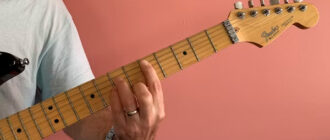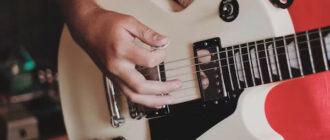
How to Toughen Fingertips for Guitar: A Beginner’s Guide Are sore fingertips hindering your guitar practice? Worry not! In this post, we’ll guide you through simple tips to toughen your fingertips, helping you develop the calluses needed for pain-free acoustic or electric guitar playing. Discover the best methods, along with essential tips and warnings for achieving those coveted guitar calluses.
Table of Contents
Why Does Playing the Guitar Make Your Fingers Hurt?
Playing the guitar can cause soreness and pain in your fingertips because of the pressure required to fret the strings. When you first start to play the guitar, your fingers are not used to this pressure of a guitar string for a chord, on an acoustic guitar or on electric guitar strings, and it takes time for them to develop calluses that can handle the pressure without causing pain for the guitar player during a practice session.
How Long Does It Take to Toughen Fingers for Guitar?
The time it takes to toughen up your fingertips for guitar playing varies from person to person. Some people who are learning guitar develop calluses pretty quickly, and they do not soften with time, while for many guitarists, this may take several weeks or even months. The key is to be patient and consistent with your practice. Also, you need to remember that calluses soften up after they remain immersed in water while you continue to do your regular chores, including washing dishes, bathing, swimming, taking a shower or even when you apply hand lotion.
How to toughen fingertips for guitar?
Here are five ways to build up fingertip calluses and toughen up your fingers for guitar playing:
1. Cut Down on Practice Time but Practice More Often

Image by Julia Giacomini from Unplash
Instead of practicing for hours on end, try practicing for shorter periods of time more frequently throughout the day. This will allow your fingers to rest and recover between practice sessions, and it will also help build up calluses more quickly while the pain will not force you to stop playing. A player who takes up the guitar frequently but for shorter periods usually has more success. And if the guitar has to deal with more practices, well, that is what it is for!
2. Practice with Steel-Strings
Steel-strings require more pressure to fret than nylon strings, which can help toughen up your fingertips more quickly. If you’re not already using steel-strings, consider switching to them. It’s the best way to toughen up your fingertips while practicing the guitar.
3. Consider Using a Thicker-Gauge String
Thicker-gauge strings also require more pressure to fret, which can help build up calluses more quickly. However, be careful not to go too thick, as this can make it harder to play chords and lead to finger soreness. Nobody likes to deal with sore fingers. It can affect the playability if you are pressing too hard on the heavy-gauge strings.
4. Try to Replicate the Feeling of Pressing on Guitar Strings Throughout the Day
Throughout the day, try pressing your fingertips against a hard surface to replicate the feeling of pressing on guitar strings. This will help build up calluses more quickly and get your fingers used to the pressure. The first few days you will be constantly forgetting about that, but then you will get used to pressing the fingers together to practice them even without the guitar.
5. Put Rubbing Alcohol on Your Fingertips
Rubbing alcohol can help toughen up your fingertips and speed up the development of calluses. Simply soak your fingertips in rubbing alcohol for a few minutes several times a day. Wait till your hands are dry and clean and not bleeding, if you accidentally pressed too hard. If you apply the alcohol on sore fingertips, it will take you back where you started, because it will be too painful to play, and the hard-earned calluses will disappear.
How Can I Strengthen my Fingers for Guitar?
In addition to building up calluses, you can also strengthen your fingers to make playing the guitar easier and reduce the risk of tendonitis. Here are some tips for finger strengthening exercises:
1. Use a credit card in your pocket
Some players put an old credit card in their pocket and use it to do finger presses throughout the day. This replicates the feeling of heavy gauge strings.
2. Practice with heavy gauge strings
Playing with heavier gauge strings can also help to strengthen your fingers.
3. Use super glue
Another trick is to use super glue to harden the skin on your fingertips. Simply apply a thin layer of super glue to your fingertips and let it dry. This might look like cheating. But you know, the famous guitarist Stevie Ray Vaughan used to create fake calluses with glue. The important part is that you are still able to play comfortably. Everyone who takes this advice should be careful that the glue is not toxic.
How Do I Stop my Fingertips from Hurting when I Play Guitar?

Image by Jose López Franco from Unplash
If your fingertips are sore after playing the guitar, there are a few things you can do to reduce the pain:
1. Keep your nails short.
Long nails can make it harder to fret the strings and lead to finger soreness.
2. Use rubbing alcohol.
This is called “Eric Clapton’s famous elixir”. As mentioned earlier, rubbing alcohol can help toughen up your fingertips and reduce soreness. Another variant is apple cider vinegar to form calluses faster.
3. Use topical anesthetic products.
Topical anesthetic products containing benzocaine – toothache creams, for example – can also be applied to your fingertips to reduce pain which will help maintain calluses, because there will be no pain when you are starting to play.
Tips
– Start the process of building calluses slowly, and gradually increase your practice time and pressure so that no matter what happens, you do not want tot stop playing because it is painful.
– Use the right string gauge for your playing level. Thickness of strings is really important.
– Relax your fingers when playing chords or fretting the strings.
– Take breaks when you feel any finger pain.
– Don’t press too hard on the fretboard and the strings, professional guitarists press with the right amount of force.
Warnings
– Avoid using too much pressure when pressing on the strings, as this can lead to blister and soreness.
– Ice cube can be a great way to reduce the pain of sore fingers.
– Using super glue is a temporary solution.
– The greatest danger for developing calluses on your fingertips is to stop playing the guitar altogether.
In conclusion, toughening up your fingertips for guitar playing can take time and patience, but it’s worth it. With the right techniques and consistent practice, you’ll be able to develop calluses on your fingers that make it easier to play your guitar without pain. Whether you’re a beginner or an experienced guitarist, building calluses can make your guitar playing career much easier and lead you to a beautiful sound. So, go ahead, start the process, and don’t give up until you get there!






